| Specification | PSS.2 |
|---|---|
| Power | 3.0 kW three-phase |
| Processing Capacity | 350 – 500 kg/hour |
| Hopper Design | Integrated stainless hopper with internal auger feed |
| Outlet Connection | DIN 50 stainless coupling |
| Discharge Hose | 8 m length × 50 mm diameter |
| Material | AISI 304 stainless steel |
| Power Supply | 400 V / 50 Hz / 3 Phase |
| Dimensions (mm) | Approx. 880 (L) × 480 (W) × 550 (H) |
| Manufacturer | MORI-TEM s.r.l., Italy |

| File | Title | File Description | Type | Section |
|---|---|---|---|---|
| 154_Scheda_POMPA-SANSA-PSS.1-2.pdf | Waste Trough and Pump PSS1 & PSS2 | Brochures | Document |
RESEARCH
8/11/21: Currently around 3.2 million tonnes of olive oil is produced annually in the world (Statistica.com) leading to the generation of large amounts of olive oil production waste. Spain is the largest producer of olive oil in the world accounting for 69% of total global production.
In the early 1980’s the introduction of three-phase production was considered a new era in olive oil processing technologies and considered as a newer, cleaner, and more efficient system was developed in place of the traditional press. In the 1990’s again a new and rather innovative two-phase centrifugation system for olive oil extraction quickly replaced the three-phase system and resulted in even higher quality olive oils.
This revolutionary olive oil extraction system certainly had its advantages. Production of olive oil at say 20% meant production of waste was being produced at around 80% and in a short space of time throughout the harvest season. This new waste is called ‘two-phase olive mill waste’ (TPOMW), ‘‘alperujo’’. In Spain, around 4 million tonnes of TPOMW is generated annually (FAOSTAT, 2012), causing serious management problems due to the phytotoxicity and slurry texture of the TPOMW.
Spanish researchers from Venta del Llano del Instituto Andaluz in Jaen looked at the possible applications for two-phase olive mill waste and the potential negative effects on olive oil quality and yield. Researchers also compared the compost addition from mill waste with mineral fertilisation and sustainability.
The olive husk was separated in the three-phase extraction system and underwent a second oil extraction with solvents after its drying. However, when TPOMW was treated similarly, significant difficulties appeared due to its high moisture and low fat contents. The TPOMW waste required a drying process before the second oil extraction which significantly increased production cost due to the increased demand of energy and higher temperatures which degraded oil quality.
Different technologies have been proposed for TPOMW treatment based on:-
- evaporation ponds
- thermal concentration
- phenolic components extraction and its application to agricultural soils to enhance the absorption of herbicides and insecticides
With sustainable practices, reducing environmental pollution, and investing in nature-based solutions on the rise, along with current targets of net-zero carbon emissions target by 2050 in other energy sectors, the olive industry certainly has its advantages here with 10.85kg of CO2 captured for every litre of olive oil produced. Sustainability practices are widespread in the olive industry.
In terms of olive oil production waste, composting as a method for preparing organic fertilizers and preparation is economically and ecologically sound and may well represent an acceptable sustainable solution in heading towards more nature-based solutions for the usage of TPOMW.
The physicochemical characteristics of TPOMW are adequate to be used in agriculture as an organic input, such as a slightly acidic pH (4.8–5.6), an intermediate level of Nitrogen, mainly organic, and also a significant quantity of other plant nutrients such as Potassium, Phosphorus, Calcium, Magnesium, and Iron.
An important feature of olive mill wastes is the high potassium concentration as this element is absorbed in large amounts by olive trees and is the most abundant nutrient in olive fruits.
Another important advantage of this olive mill waste is the high organic matter concentration free of heavy metals and other potential pollutants being potentially a cleaner input option for producers.
Researchers noted “All the composts used in this experiment presented a balanced amount of mineral which supplied the nutrient required for the good development of the plant. The amended soils had a higher content of N, P, K, and organic matter than the soil with inorganic fertilizer. The increase in soil fertility of the compost amended soils produced a significant increase in the olive oil content of the fruits, maintaining similar composition and quality of olive oil as the control. Composting TPOMW with agricultural wastes can be an environmentally friendly solution to the disposal problem of these wastes and an adequate low-cost strategy for the recycling of olive oil by-products”.
This research is interesting because it shows how producers can implement more sustainable practices in their overall production, enhance olive tree cropping, maximise yield, and potentially lower costs of total inputs.
Abstract
Composting is a method for preparing organic fertilizers that represents a suitable management option for the recycling of two-phase olive mill waste (TPOMW) in agriculture. Four different composts were prepared by mixing TPOMW with different agro-industrial by-products (olive pruning, sheep manure and horse manure), which were used either as bulking agents or as N sources. The mature composts were added during six consecutive years to a typical ‘Picual’ olive tree grove in the Jaén province (Spain). The effects of compost addition on soil characteristics, crop yield and nutritional status and also the quality of the olive oil were evaluated at the end of the experiment and compared to a control treated only with mineral fertilization. The most important effects on soil characteristics included a significant increase in the availability of N, P, K and an increase of soil organic matter content. The application of TPOMW compost produced a significant increase in olive oil content in the fruit. The compost amended plots had a 15% higher olive oil content than those treated with inorganic fertilization. These organics amendments maintained the composition and quality of the olive oil.
Authors: Antonia Fernández-Hernández a,⇑ , Asunción Roig b , Nuria Serramiá b , Concepción García-Ortiz Civantos a , Miguel A. Sánchez-Monedero b
- a Centro ‘Venta del Llano’ del Instituto Andaluz de Investigación y Formación Agraria, Pesquera, Agroalimentaria y de la Producción Ecológica, Mengíbar, Jaén, Spain
- b Department of Soil and Water Conservation and Organic Waste Management, CEBAS – CSIC, Murcia, Spain
Read the full study at https://www.sciencedirect.com/science/article/abs/pii/S0956053X14001378
OLIVE OIL PROCESSING
For businesses and serious growers considering olive oil extraction, the idea of owning a machine for under $10,000 may seem like an attractive entry point. However, achieving high-quality olive oil requires advanced extraction technology that meets food-grade standards. The extraction process is highly technical, demanding specialised equipment to maintain oil integrity and efficiency. This guide will help you understand the essential components of olive oil processing, the investment required, and the best options for entering the market.
Many low-cost machines marketed for oil extraction—often priced around $2,000—are screw presses designed for seed and nut oils. These do not meet the requirements for proper olive oil extraction. Producing premium extra virgin olive oil requires specialised machinery that includes:
Without these advanced components, it is impossible to produce high-quality olive oil that meets commercial standards.
Each of these stages demands industrial-grade technology, making low-cost extraction machines impractical for producing high-quality olive oil.
For those serious about maintaining full control over their production, the Frantoino Olive Oil Press is an excellent entry-level option. With a processing capacity of up to 50kg per hour, it delivers professional-quality results in a compact and efficient design. Owning your own machine ensures complete flexibility and control over your olive oil production.
f you’re looking for a cost-effective alternative, buying a used machine can provide savings while still allowing you to own your equipment. Though used machines can be harder to source, platforms such as Olive Machinery list available second-hand units.
For those not ready to invest in machinery, a local processing facility provides access to high-grade extraction equipment without the capital investment. To find a processor near you, use The Olive Centre’s Processor Map.
Producing high-quality olive oil requires investment in the right equipment and processes. Whether you choose to own a professional machine like the Frantoino, explore second-hand options, or utilise a local processing service, there are solutions to suit different business needs. For those prioritising full control and flexibility, investing in specialized extraction equipment is the best path forward. However, used equipment and local processors provide accessible alternatives for those looking to test the market before committing to a larger investment.
For decades, engineers have envisioned a compact, efficient, and hygienic machine capable of producing extra virgin olive oil on-site. That dream is now a reality. Modern technology has made it possible for growers to produce their own extra virgin olive oil using a self-contained, economical system that delivers professional-grade results.
This innovation empowers Australian olive growers to add value to their produce - from picking and processing to bottling - using their own equipment. Beyond personal production, it opens the door for entrepreneurs to establish contract processing businesses, pressing olives for others with ease and precision.
Centrifugal extraction technology was a revolution in the olive oil industry. It replaced older, labour-intensive systems with continuous-flow designs that offered greater hygiene, improved labour efficiency, and higher capacity. These advances quickly made the traditional hydraulic press obsolete.
In the past, Mediterranean growers would haul heavy sacks of freshly picked olives - often already fermenting - to local mills. There, they would join the community in spreading the crushed paste onto mats and watching as hydraulic presses squeezed out the golden liquid. It was a scene rich with tradition, aroma, and anticipation.
Today, the romance of that process has given way to something far more refined. Continuous-flow extraction plants now accept fruit within 48 hours of harvest to prevent overheating and fermentation. Delivered in ventilated plastic crates, the olives enter stainless steel systems that maintain strict hygiene standards, emerging as pure, high-quality oil. The process may lack the old-world spectacle, but it ensures superior product consistency and safety.
Currently, hundreds of Australian processors are already achieving outstanding results with Oliomio systems, producing exquisite extra virgin olive oil from their own fruit. True to its name - Oliomio, meaning “My Oil” - this technology gives growers full control over every stage of production, from fruit to finished bottle.
Each Genuine Oliomio machine is backed by excellent technical support provided by The Olive Centre, the exclusive Australian distributor. The Olive Centre offers on-site installation and comprehensive after-sales care to ensure growers get the best possible results from their investment.
The rise of accessible, high-performance extraction equipment marks a turning point for the Australian olive industry. Growers can now operate with greater independence, reduce processing costs, and elevate the quality of their oil - all while maintaining the authenticity and freshness that consumers demand.
As The Olive Centre team notes, this innovation was made possible thanks to the enthusiasm and vision of Australian olive growers themselves. Their commitment to excellence has driven this exciting step forward in local production.
Whether you’re looking to press your own olives or launch a boutique processing service, Oliomio offers a practical, proven pathway to success. For more information and a free information booklet, contact The Olive Centre - and take the first step toward making “My Oil” truly your own.
See More: Oliomio Machinery
OLIVE OIL PROCESSING MACHINERY
Barigelli olive oil machinery installations detail the complete journey from fruit preparation to final oil extraction. Each installation shows how individual components-crushers, malaxers, decanters, and clarification systems - work in synchrony to deliver consistent, high-quality olive oil. The following sections summarise each functional stage of the production line, referencing installation examples.
This installation combines olive crushing and paste malaxing in a compact continuous system. The crusher prepares the olive paste uniformly before transfer to the malaxing tanks, where controlled mixing optimises oil separation. Integrated control settings manage paste temperature, timing, and batch flow to maximise extraction efficiency.
Image: Vertiical Separator with Stand, Malaxing Unit with Crusher, Decanter & Control Panel all connected with raceway.
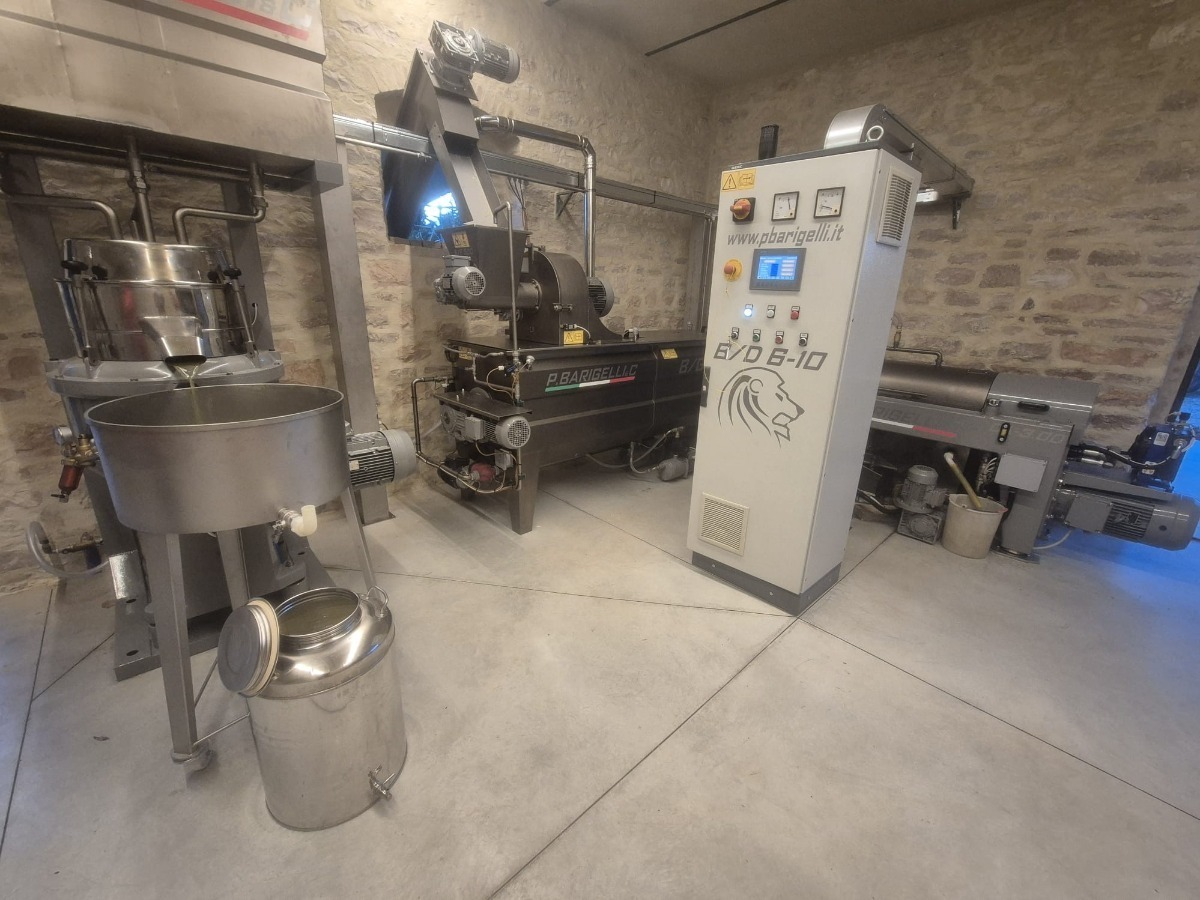
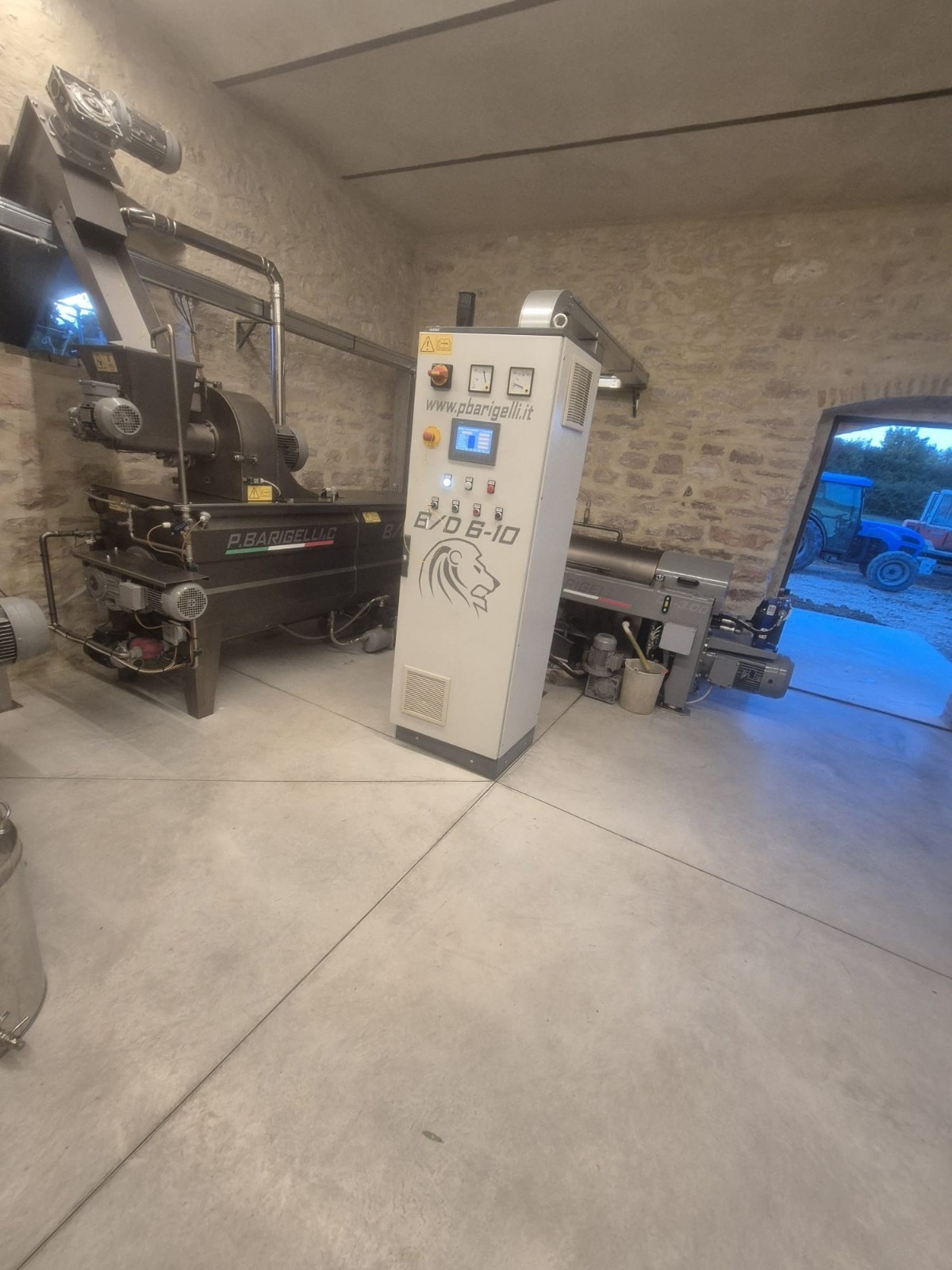
This installation showcases the Barigelli BVD 6-10 olive oil extraction system equipped with an integrated control panel. The setup includes a crusher, malaxing system, and decanter, designed for continuous olive oil processing. The control panel allows operators to manage temperature, timing, and extraction parameters for optimal oil yield and quality.
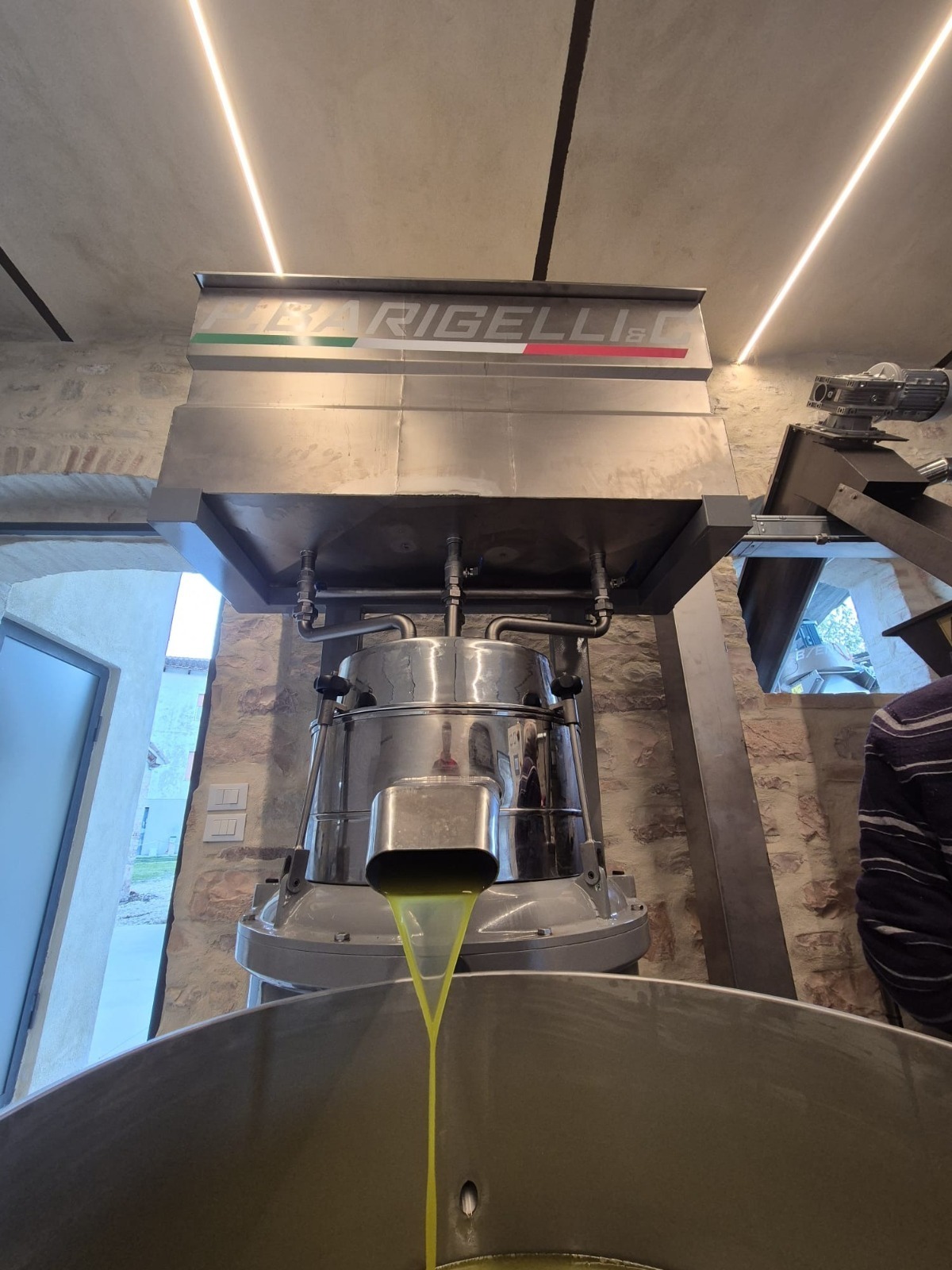
Barigelli stainless steel vertical separator in operation, showcasing freshly extracted olive oil flowing smoothly from the outlet into the collection tank. The design ensures efficient liquid separation of oil while preserving aroma, colour, and quality of extra virgin olive oil.
Barigelli’s high-capacity decanter systems designed to separate oil, water, and solids in a single continuous process. The horizontal design ensures high separation efficiency, reduced energy consumption, and easy maintenance access for operators.
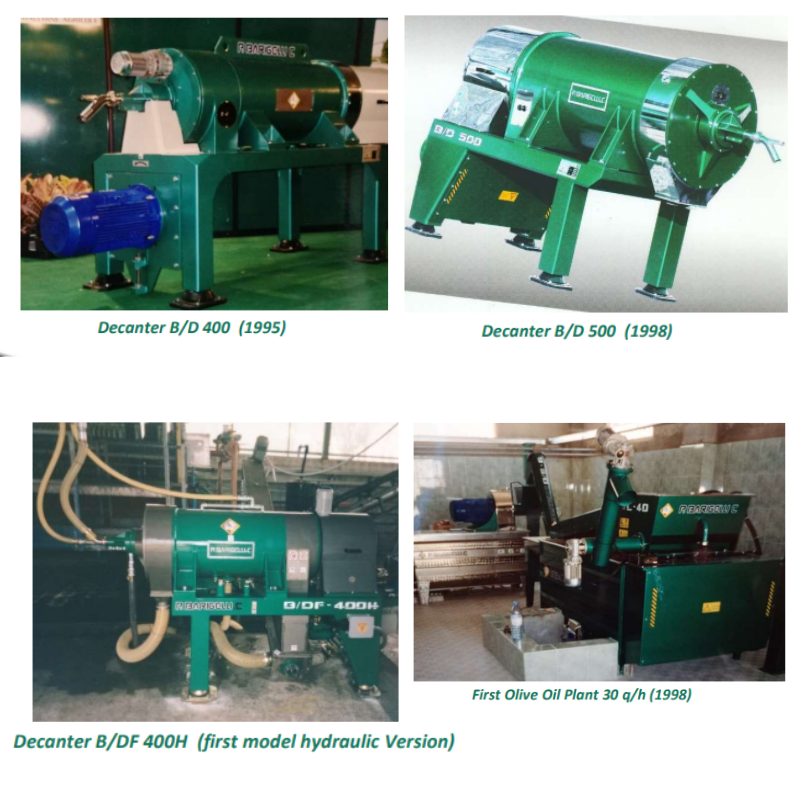
Barigelli Early Decanter Models and First Olive Oil Plant
Barigelli’s pioneering olive oil extraction technology - from the early B/D 400 (1995) and B/D 500 (1998) decanters to the B/DF 400H hydraulic version and the first complete olive oil plant (1998). These models mark the foundation of Barigelli’s innovation in continuous olive oil processing systems.
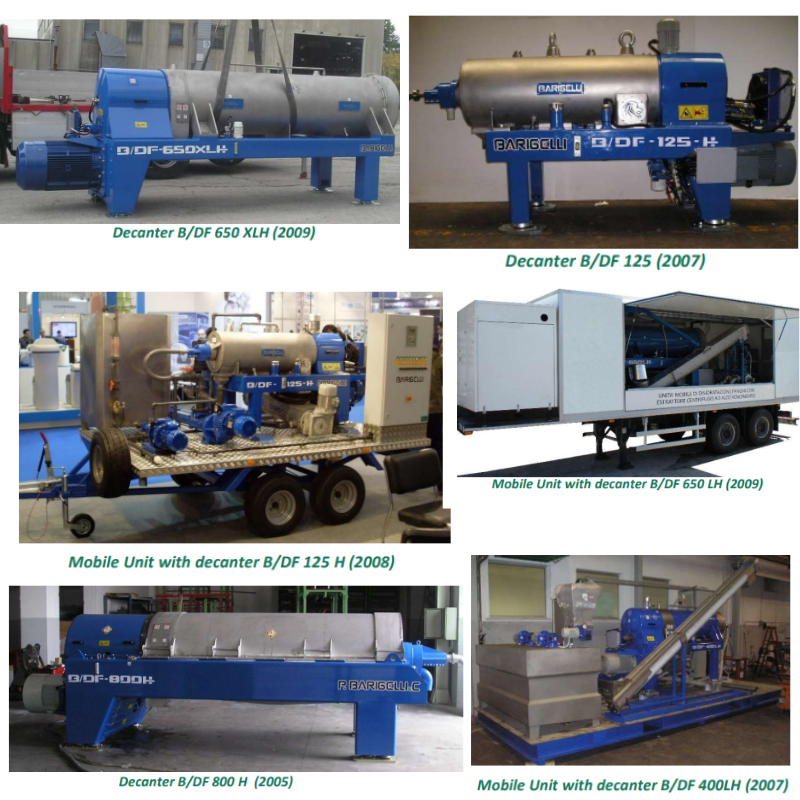
Barigelli Decanter and Mobile Extraction Units (2005 - 2009)
Barigelli’s advanced range of decanters and mobile olive oil extraction units developed between 2005 and 2009. The models include B/DF 125 (2007), B/DF 800H (2005), and B/DF 650 XLH (2009), alongside mobile versions such as the B/DF 125H (2008) and B/DF 400LH (2007). These systems represent a leap in continuous extraction technology, combining high efficiency, portability, and precision oil separation.

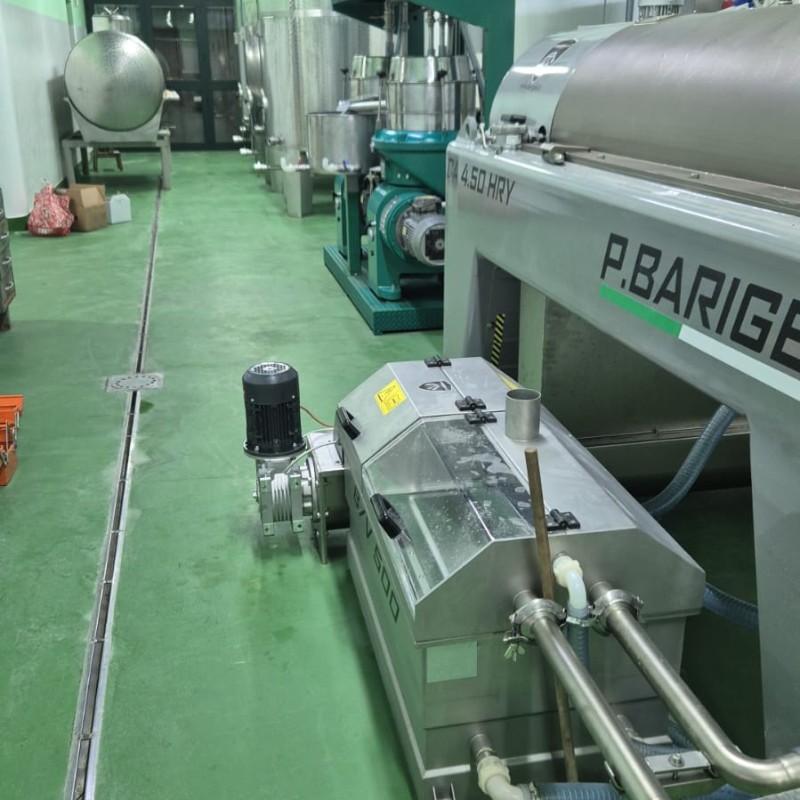
Barigelli 4.50 HRY olive oil extraction setup featuring stainless steel decanters, pumps, and separator units. The continuous line integrates crushing, malaxing, decanting, and final clarification, designed for high-capacity and consistent extra virgin olive oil production.
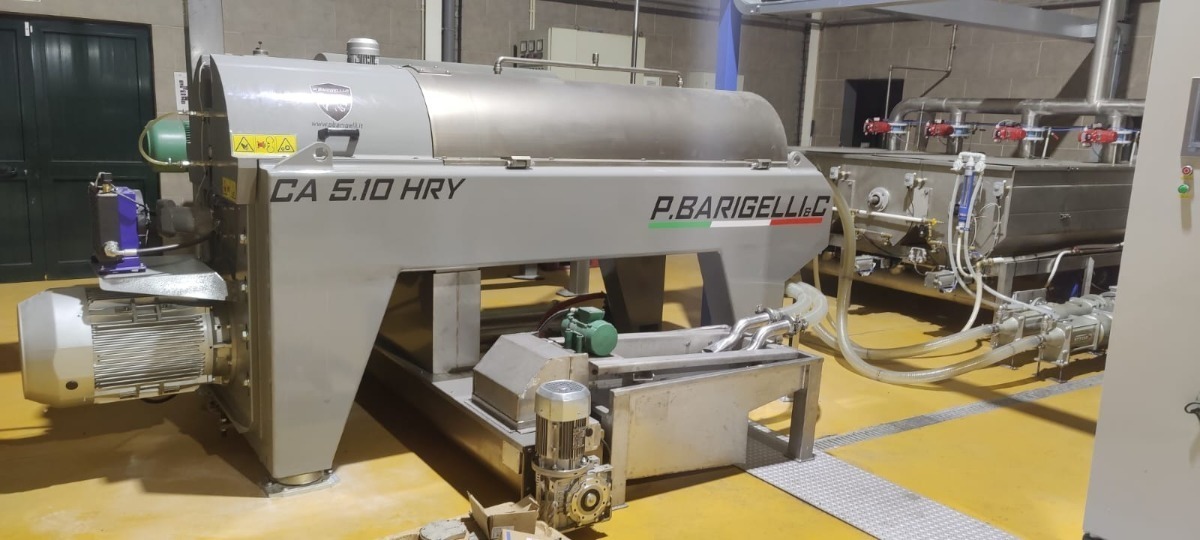
Barigelli CA 5.10 HRY decanter, a high-efficiency centrifuge designed for large-scale olive oil extraction. Built with precision stainless steel, the system separates oil, water, and solids in a continuous process, ensuring maximum yield and superior oil quality.
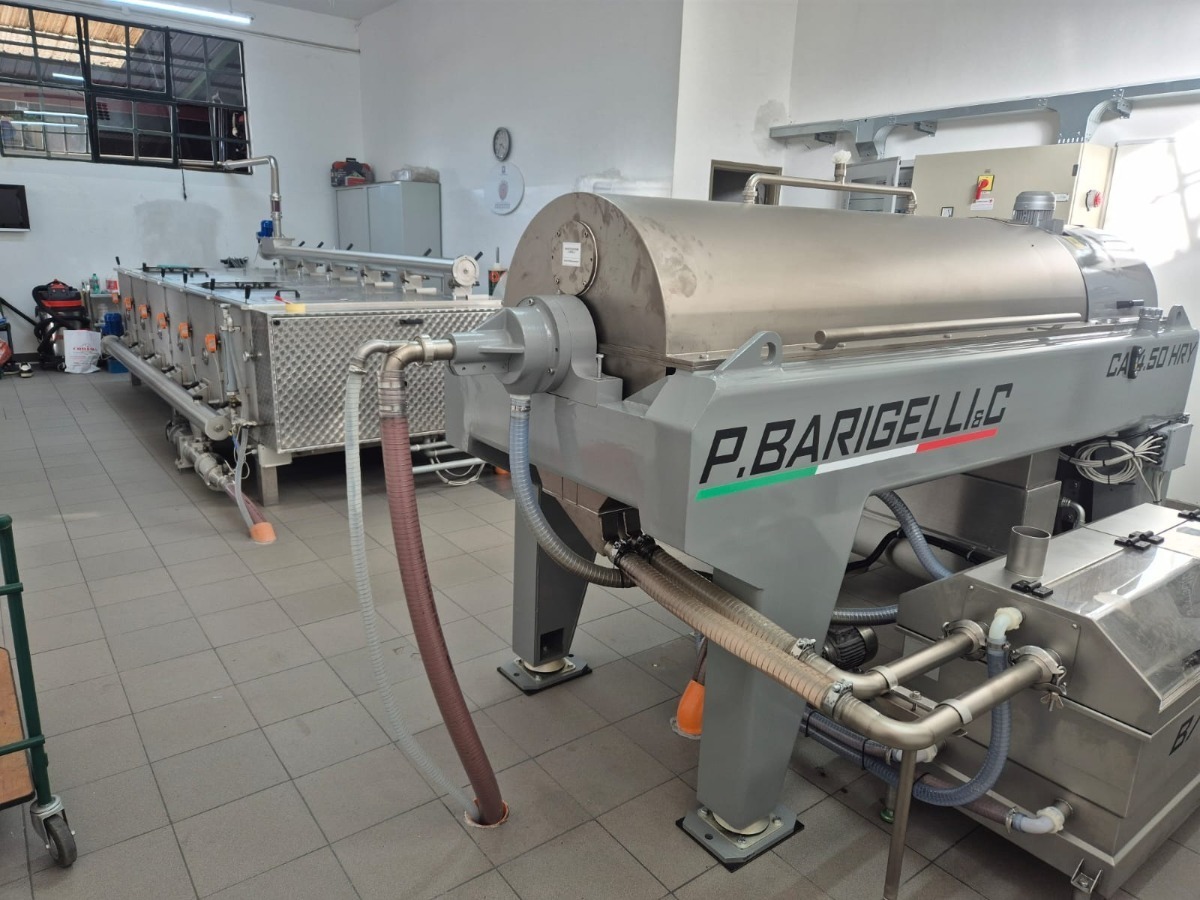
Different malaxing setups can be offered in a linear system, stacked or as a bank setup.
Barigelli Olive Oil Processing Installation
Barigelli Olive Oil Processing Installation on working
Oil clarification are critical steps that can help to maintain the purity, stability, and quality of extra virgin olive oil. Once oil has been separated in the decanter, it still contains microscopic solids, waxes, and water traces. Vertical separators separate unwanted parts to minimise fermentation and cloudiness, ensuring that the oil remains bright, aromatic, and longer-lasting. Barigelli systems feature stainless-steel food-grade modules integrated directly into the processing line, allowing continuous operation without halting production or creating bottlenecks. Their modular construction supports single or multi-stage malaxation.
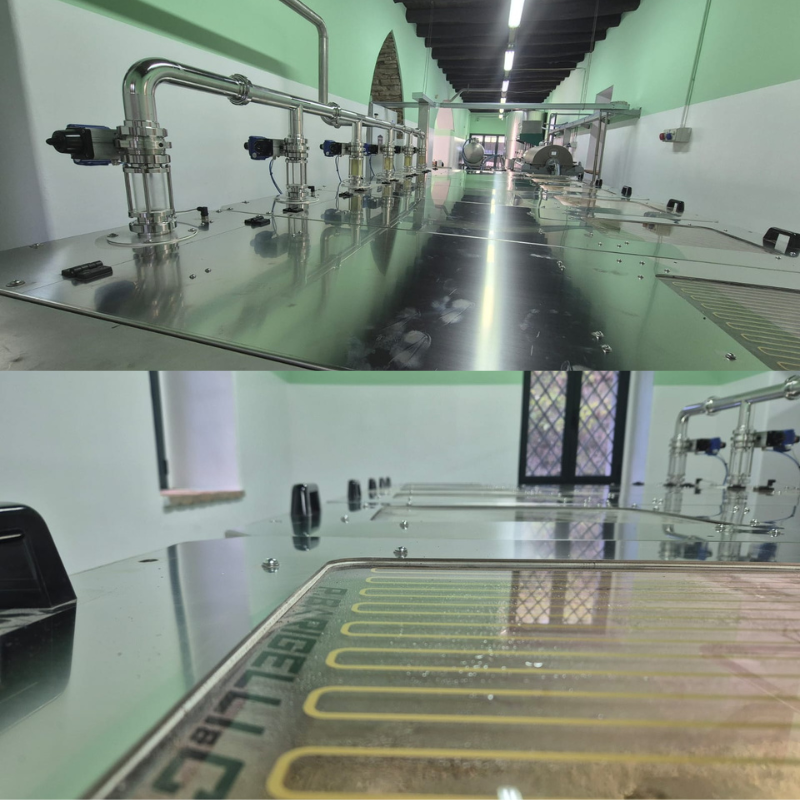
Barigelli stainless-steel feed system with inline sight-glass valves and transparent inspection panels. Designed for continuous olive oil feed.

Barigelli Malaxing tank showing olive paste during the malaxation phase. The transparent inspection lid allows operators to monitor flow and sediment removal, ensuring consistent oil purity before final separation.

Barigelli transparent sight chamber showing paste flow during malaxation. The precision assembly allows real-time visual monitoring of paste flow.

Barigelli multi tank malaxing facilitating automatic paste transfer with solenoids.
Barigelli’s complete olive oil processing lines integrate every stage of production into a single automated system. From olive crushing to oil clarification, each unit ensures precision control, continuous flow, and consistent extraction results tailored to the producer’s scale.

A fully installed Barigelli line featuring the CA 510 HRY horizontal decanter and automated control system. This configuration offers real-time process monitoring, stable separation, and high extraction efficiency within a compact plant layout.
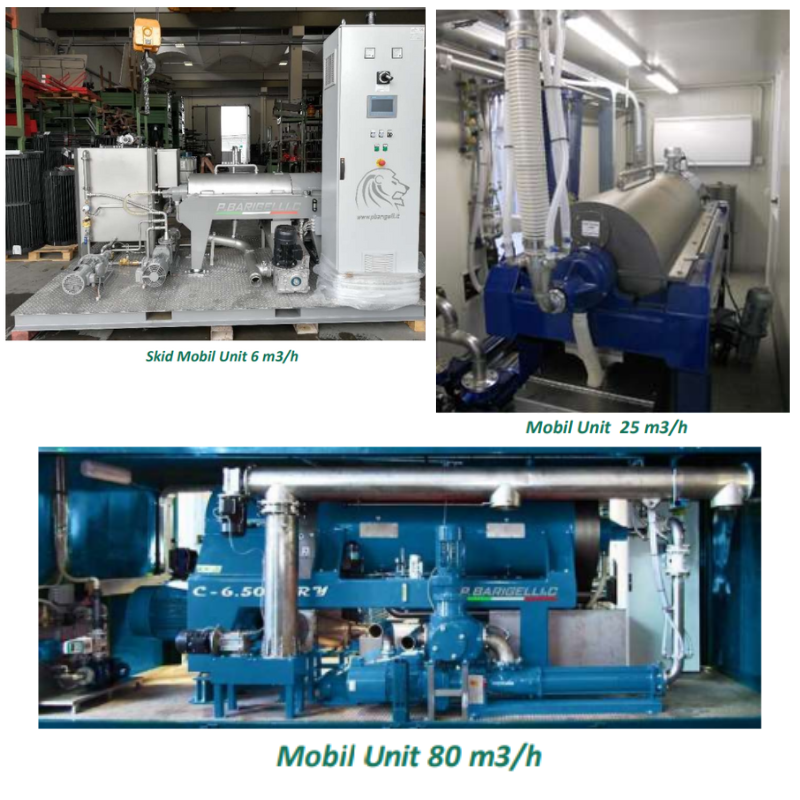
A series of mobile Barigelli units designed for flexible deployment in field or facility operations. Available in multiple capacities (6, 25, and 80 m³/h), these compact systems provide full olive oil extraction and clarification capability on-site for portable or remote production environments.
|
Type |
Decanter Type | Working Capacity | Installed Power | Power Consumption | Water Consumption | L/hr | ||
|
|
|
Kg/hr | kW | kW | 2 Phase | 3 Phase | ||
| 6 - 10 Junior | B/D 300 | 300/500 | 22.5 | 15 | 0 | - | ||
| 20 - 25 | B/D 400 | 800/1100 | 50 | 28 | 0 | 160/250 | ||
| 35 - 45 |
B/D 400L |
1400/1800 | 50 | 34 | 0 | 160/250 | ||
| 50 - 60 |
B/D 500 |
2000/2500 | 75 | 55 | 0 | 200/350 | ||
| 70 - 95 |
B/D 500L |
3000/4000 | 90 | 75 | 0 | 250/350 | ||
| 115 - 150 |
B/D 650 |
6000/7000 | 140 | 110 | 0 | 500/700 | ||
| 150 - 200 |
B/D 650L |
7000/9000 | 170 | 125 | 0 | 700/900 | ||
|
|
|
|
|
|
|
|
||
Each Barigelli installation demonstrates efficient integration of key processing stages—crushing, malaxing, decanting, clarification, and control - within a single automated framework. The result is precise, continuous olive oil production tailored to modern operational standards. These installations reflect the reliability and scalability essential for both boutique and industrial olive oil processors.
Modern extra virgin olive oil (EVOO) production relies on continuous centrifugal extraction, which has largely replaced traditional presses. In a continuous system, olives are cleaned, crushed into paste, and then malaxed (gently mixed) before a horizontal decanter centrifuge separates oil from water and solids. This process is far more efficient and hygienic than the old press-and-mat method, which is now considered obsolete. Key quality factors include processing fruit quickly to avoid fermentation, maintaining low temperatures during malaxation, and minimising exposure to oxygen. For example, transporting olives in ventilated crates and crushing/milling within 24-48 hours of harvest helps prevent heat buildup and unwanted fermentation that could spoil flavour. Cleaning and de-leafing the fruit before crushing is also critical - removing leaves, dirt, and debris ensures no off-flavours or contaminants make it into the oil. Mordern mills typically incorporate washing and leaf-removal steps for this reason.

Temperature control is paramount during extraction. EVOO is generally produced under “cold-press” conditions, meaning malaxation is kept around ≤27 °C to preserve aromatic compounds and polyphenols. Longer malaxation times or higher temperatures can increase yield but will reduce polyphenol content and flavour freshness. Recent research confirms that malaxation time and temperature must be optimised per cultivar e.g., one study found that extending malaxation from 15 to 90 minutes caused polyphenols to drop by up to 70%. In Australian groves, where harvest season temperatures can be high, processors often monitor paste temperature closely and may use heat exchangers or vacuum conditions to control it. Shorter malaxation (20-40 minutes) at moderate temperatures is commonly employed to balance oil yield with quality retention. Equally important is timing from harvest - olives allowed to sit too long (especially in warm conditions) will start fermenting. Using shallow, well-ventilated bins and milling within a day of picking is recommended to keep olives cool and intact. Big Horn Olive Oil in USA, for instance, emphasises rapid processing: they cold-press olives within 2 hours of harvest to “lock in freshness and antioxidants,” drastically reducing oxidation time in between. Such practices help Australian producers achieve long shelf life (18 - 24 months) and vibrant flavour in their EVOO whereas Cockatoo Grove has a Midnight EVOO where they pick and press in the cool of the night.
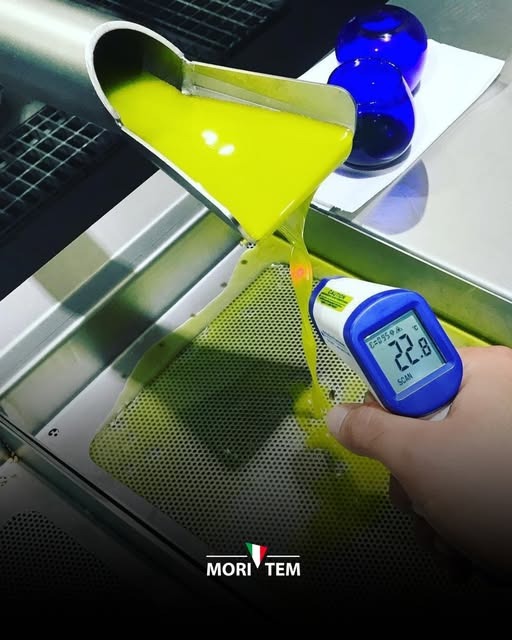
Ongoing research in Australia has highlighted how harvest timing and orchard factors influence oil quality. As olives mature on the tree, oil yield rises, but phenolic compounds (antioxidants) tend to drop. In field trials across New South Wales and Victoria, early-harvest olives produced oils with higher polyphenol content and longer shelf stability, whereas late-picked fruit gave more mellow oils with lower antioxidant levels. Free fatty acidity and peroxide (rancidity indicators) remained low until fruit became overripe, but antioxidant-rich components like tocopherols and polyphenols decreased as the fruit matured, leading to reduced oxidative stability in late-season oils. Australian producers must therefore balance quantity vs quality: an early pick yields robust, pungent oils rich in healthful polyphenols, while a later pick yields more volume with milder taste. The table below (adapted from industry data) illustrates this trade-off:
| Harvest Time | Oil Yield (% by weight) | Flavor Profile | Antioxidant Level |
|---|---|---|---|
| Early (greener fruit) | ~12-16% (lower) | Green, grassy, intensely fruity; pronounced bitterness & pungency | High (rich in polyphenols) |
| Mid-Season | ~15-18% (moderate) | Balanced fruitiness; moderate pepperiness | Moderate |
| Late (ripe fruit) | ~20-28% (higher) | Mild, buttery, nutty; low bitterness/pungency | Lower (fewer polyphenols) |
Other local research has examined irrigation effects on oil quality. Water-stressed olive trees (common in Australian summers) often produce smaller, more bitter fruit with higher polyphenol content, whereas heavily irrigated trees yield plumper olives with diluted phenolics but higher total oil output. For example, a study found that deficit-irrigated trees had the highest polyphenol levels (and earlier fruit ripening) in dry years, while fully irrigated trees gave greater oil yields at the cost of some phenolic concentration. These findings underscore that post-harvest decisions (when to pick, how to handle fruit before milling/crushing) are just as crucial as the milling technology itself. Cutting-edge extraction equipment can maximise quality potential, but growers must still deliver quality olives to the mill and process them with urgency to produce premium Australian EVOO.
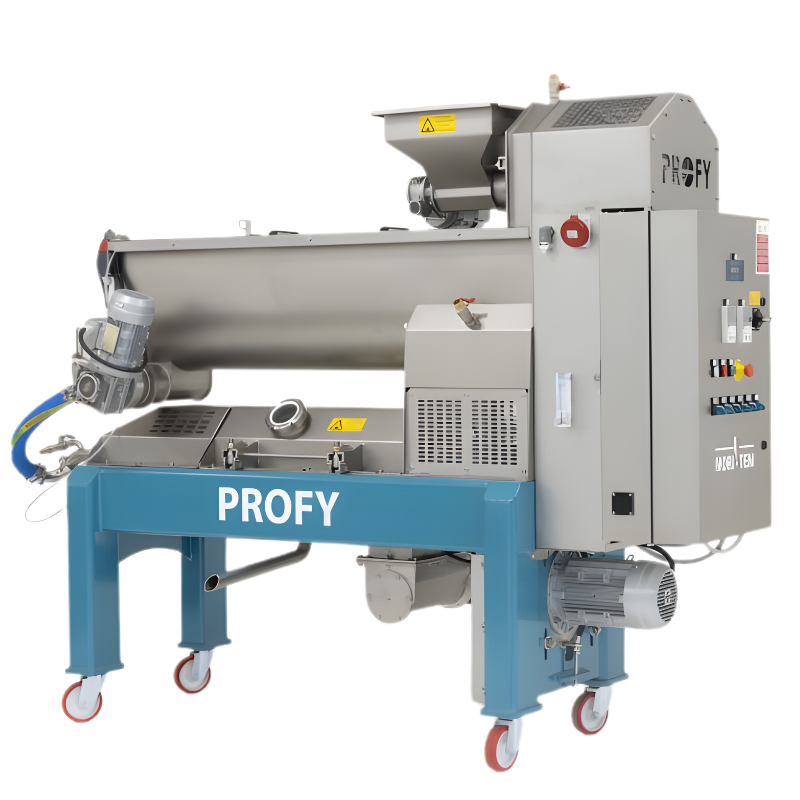
MORI-TEM offers a spectrum of Oliomio mills to suit different scales, from artisanal boutique producers up to small commercial cooperatives. All share the principles above, but with varying throughputs and degrees of automation. Below is an overview of the current Oliomio lineup and its characteristics:
To summarise the small-to-medium Oliomio models discussed above, the table below compares their capacities and key features:
| Oliomio Model | Throughput | Key Features | Typical Application |
|---|---|---|---|
| Spremoliva C30 | 30-40 kg/hour | Batch malaxer (discontinuous); basic mini-press setup; no built-in heating or automation | Hobbyists, micro-batch or lab use (older design) |
| Frantoino Bio | ~50-60 kg/hour | Continuous 2-phase system; single malaxer; simple controls; single-phase power; adjustable decanter nozzles | Boutique farms, artisanal producers, pilot plants |
| Oliomio 80 Plus | ~70-80 kg/hour | Continuous flow; horizontal malaxer with heating & temperature display; inverter speed control; basic CIP wash kit | Small farms (~0.5-1 ton/day harvest); estate olive groves |
| Oliomio Gold | ~90-100 kg/hour | Enhanced automation (auto malaxer & drum washing, variable-speed feed auger)waste pump included; single or 3-phase | Medium farms (~0.8 ton/day); premium boutique mills needing labour-saving features |
| Oliomio Profy 200 | ~150-200 kg/hour | Dual malaxers for semi-continuous processing; heavy-duty crusher; closed/vacuum malaxing; full automation; waste pump | Cooperative regional mills; small commercial processors (~1.5-2 ton/day) |
Table: Comparison of select Oliomio continuous mill models (MORI-TEM). All feature two-phase extraction, stainless steel construction, and integrated crushers and decanters; higher models add more automation and capacity. Note how the traditional press is absent - even the smallest Oliomio brings modern centrifugal extraction to the farm, highlighting the leap in technology from the old press or “monoblocco” mills of past decades.
For producers scaling beyond the monobloc units, MORI-TEM offers modular olive mill installations that handle larger throughputs while prioritising quality. These systems - marketed under names like Sintesi, Forma, Cultivar, and TecnoTEM Oliomio Sintesi Series - break the extraction process into separate machines (e.g., independent crusher, malaxer group(s), decanter, separator) designed to work in harmony. They introduce features like multiple malaxers for higher throughput, vacuum malaxation technology, and advanced control systems. Importantly, they still operate on the continuous two-phase principle and embody the same hygiene and automation ethos as the smaller Oliomio range. Here’s an overview of each series:
It is instructive to contrast the above Oliomio technologies with the outdated systems they have superseded - namely, the classic hydraulic press and early-generation farm mills (older “monoblocchi” units). Traditional olive presses involved grinding olives (often with stone mills) into paste, spreading that paste onto fibre mats, stacking them, and then applying tons of pressure in a press to squeeze out the oil/water mixture. This method, while romantic, had numerous drawbacks: it was labour-intensive and slow, exposed the olive paste to air for prolonged times, and was hard to keep clean. The mats and press equipment could harbour yeasts or moulds and were difficult to sanitise thoroughly. It was not uncommon for olives to begin fermenting in the interim between harvest and pressing - indeed, historical accounts describe farmers bringing sacks of olives to the mill that were “often already fermenting” by the time they were pressed. The result was oil of inconsistent quality and stability. Continuous centrifuge systems like Oliomio eliminated these problems by moving to an enclosed, stainless-steel process where olives are milled almost immediately after picking, drastically cutting the chance for fermentation or oxidation. The greater hygiene and speed of continuous extraction have improved average oil quality and made defects from processing (such as fusty or musty flavours from fermentation) much rarer in modern operations. As a report on introducing Oliomio technology in Australia noted, “centrifugal extraction…replaced older, labour-intensive systems with continuous-flow designs”, offering better hygiene, efficiency, and capacity - effectively rendering the old press method obsolete in quality-oriented production.
Early small-scale continuous mills (from the 1990s-2000s) were a huge step up from presses, but they lacked some refinements of today’s Oliomio models. For example, many older farm mills did not have automated temperature control for malaxation, nor continuous malaxer flow. The very first “Oliomio” monoblock (created by Tuscan innovator Giorgio Mori) was revolutionary for being compact and continuous, but subsequent generations have added further improvements. A comparison of features illustrates this evolution: the older Spremoliva 30 could only malax in batch mode (no simultaneous crushing while decanting) and had no heating system or temperature display on the malaxer. By contrast, an Oliomio 80 or Gold today has fully continuous malaxing with automated temperature control and readout. Earlier mills often used fixed-speed motors and one-size-fits-all settings, whereas new systems employ inverter drives and adjustable nozzles to accommodate different olive conditions (small, watery olives vs. large, fleshy ones, etc.). Another big leap is in automation: tasks like pomace removal and equipment washing, once manual, are now handled by integrated pumps and wash cycles in machines like the Gold and Profy. This not only reduces labour but also ensures more consistent cleanliness batch after batch. In terms of energy and water usage, modern two-phase decanters are also more sustainable - they eliminate the need for large volumes of dilution water required by traditional three-phase decanters (saving water and the energy to heat it) and produce a simpler waste stream (wet pomace) that can be repurposed or composted more easily than press liquor or black water from old systems.
Crucially, oil quality has improved with each technical advance. Traditional pressing often left higher sediment and water in the oil, necessitating longer settling or filtration and risking quicker oxidation. Continuous centrifugation yields cleaner oil immediately, and the lack of air contact preserves freshness. Chemical measures like peroxide value and UV stability are typically superior in oil produced by a modern continuous mill versus an old press, when starting with the same fruit. The ability to crush and extract within hours of harvest, at controlled temperatures, means free fatty acid levels stay extremely low and the positive flavour notes are maximised. Australian producers who have adopted the latest Oliomio systems consistently report better quality and consistency in their oils, even when processing smaller batches. As an example, Spring Gully Olives in Queensland upgraded to a two-phase Oliomio (150 kg/hr) and found it ideal: it allowed them to process their own crop and offer custom processing to neighbouring groves, all while producing oil that needed no further refining - “the 150 kg per hour Oliomio is an ideal capacity which allows small growers to have their own oil processed…and it leaves the oil in its natural state”. This kind of feedback underlines how modern machinery empowers even small-scale growers to achieve high extraction efficiency and premium quality that rivals the big producers.
In summary, the latest Mori-TEM Oliomio systems represent a convergence of advanced engineering and practical on-farm olive oil production. They enable professional, hygienic, and quality-focused extraction at scales from a few dozen kilograms up to several tonnes per hour. By carefully controlling each step - from fruit cleaning and crushing with minimal oxidation, to malaxation under controlled atmosphere, to efficient two-phase centrifuge separation - these machines ensure that the oil produced reflects the true potential of the olives. Australian growers using Oliomio equipment benefit not only from improved oil quality and shelf life, but also from greater independence and flexibility: they can harvest at optimal times and process immediately, rather than rushing to a distant community mill or risking fruit spoilage. The result is fresher, more flavorful extra virgin olive oil that meets the high standards of a sophisticated global market. And with the range of Oliomio models and configurations now available, producers can choose a setup tailored to their grove’s size and business model - whether it’s a one-person boutique press or a regional processing hub servicing multiple farms. The technology has truly opened a new chapter for the industry, one where tradition and innovation blend to produce the finest EVOO. Each bottle of oil pressed with these modern systems tells the story of careful harvest timing, immediate processing, and gentle extraction - a story that resonates strongly with Australia’s drive for quality and the world’s appreciation of premium extra virgin olive oil.

Some important research that you should know about which was funded by RIRDC....
RESEARCH This RIRDC report analyses the impact of the use of traditional and new processing aids on olive oil extraction and oil quality.
The information generated by this project aims to provide new tools for improving olive oil processing that can increase both the extraction efficiency and profitability for olive producers in the Australian industry.
The report is targeted at the relatively new and actively growing group of olive oil processors in Australia. An understanding of the use of processing aids?by oil producers will help them increase their profitability without affecting the quality of their product. Press this link ---> Download PDF (706.1 KB)
Have you assessed the power requirements of the olive oil machinery you are considering? ?Do you have single or three phase power?
The answers to these questions can be relatively straightforward or difficult and/or costly. ?Here we look to find a solution to power your machine.
Typically, we start with your Electrician or Energy Power provider. ?They should be able to ascertain the size of the transformer you have in relation to the power needed.
You may find yourself in one of these Scenarios:
Scenario 1: ?I only have Single phase but need the capacity of a Three-phase powered processing machine?
In this circumstance, if your Single phase power source is ample you may be able to have a converter fitted to your single phase electrical supply. ?There are different brands of converters. ?However, not all of them with work with the electronic equipment fitted to your machine. ?There are 2 reliable sources of units that have been installed for use with Processing machinery:
Polyphaz: ?http://www.polyphaz.com/
Scenario 2: ?I don't have quite enough power. ?What options do I have?
In this situation, you may be eligible for a transformer upgrade. This option can be explored through your Electrician or Energy Company. ?You will need to call them to ascertain if this is possible.
Scenario 3: ?I have assessed my power requirement and it is going to cost a small fortune to have the power run to where I need.
If you haven't been able to fit a converter then your second port of call might be a generator. ?It is important to match the size of the generator accurately. ?The Olive Centre is able to provide further details about generators. ?You might decide to purchase or hire a generator throughout the season(s). ?A great source of contact for generators is Macfarlane Generators who have worked with many producers: ??http://www.macfarlanegenerators.com.au/
Still, have Questions? ?Contact The Olive Centre for assistance.
Find out more about processing machinery
The product, obtained from one of the residues left over after the crushing and extraction of olive oil in mills, is marketed by the company as a fertilizer in bags which also contain mushrooms.
As a substrate for the growth of mushrooms, the product has a number of advantages, apart from being an environmentally friendly way to utilize the many tons of waste from the olive oil production process that are produced every year.
Benefits of the new substrate include higher production as a result of the high nitrogen content of the alperujo, which acts as a nutrient for the mushrooms, as well as the presence of polyphenols that act as natural fungicides that give resistance against fungal infections. Research in Argentina has also supported the technique, showing the addition of olive oil waste products to maize- and garlic-based substrates was beneficial for mushroom growth.
The new product is a follow on from previous organic substrates for mushroom growth produced by MISUR, a company that focuses on the utilisation of agricultural wastes such as cereal straw with acidity regulators, nutrients and fungi seeds, which are known as mycelia. The addition of the olive oil byproduct to these types of substrates provides extra material for the fungi to degrade and use as fertiliser for growth.
The Spanish company is currently focusing on the common mushroom and shiitake varieties, the latter of which has a high gastronomic value in Spain despite its Asian origins, and is the first company to produce organic substrates for both species.
Using olive oil waste as a substrate for mushrooms has previously been seen as an effective technique to neutralise the pollutant effect of olive oil waste that is produced in such large amounts throughout the Mediterranean region. However, it has not been successfully marketed for the growth of edible fungus before now.
MISUR products are currently being marketed throughout the region of Andalucia in southern Spain.